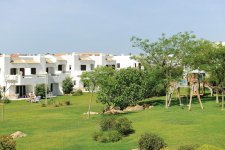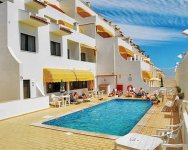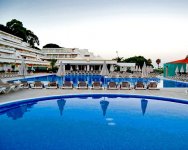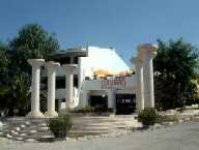
Portugal as if specially designed for those who love peace, warmth and the ocean. And in addition to the resorts themselves, there were still normal human settlements in which normal local residents live, and not just tourists and hotel staff. To walk along narrow streets, go to a local zucchini, drink a good local wine. To observe the life of small towns, which, it seems, have not been touched by time. Listen to the bells ringing, calling for the morning mass, to mix with the crowd of local residents entering the church. Go into the harbor, take a look at how the fishermen pull their catch out of the boats to the land, maybe even throw a few words with them.
Alentejo
Visitors of the Alentejo Region are at first taken by surprise by the remarkable traces of successive cultures: dolmens and cromlechs, Roman and Arab vestiges mingling with the most recent signs of Christianity, exemplified by the numerous medieval castles that stand out in the vast plain.
To the northeast are the beautiful villages and towns which make up the so-called Rota dos Castelos (Castle Route): Nisa, Castelo de Vide, Marvão, Portalegre and Alter do Chão. Further south, the landscape becomes warmer and flatter; around Évora (one of the most beautiful towns in Portugal), are Monsaraz, Vila Viçosa, Estremoz, and Arraiolos (renowned for its hand made tapestries, based on traditional drawings from the 17th and 18th centuries). Driving on to the South, the vast plains become less inhabited and sunnier, the only shade being provided by olive trees and oak trees, and the only amenity being provided by refreshing dams. A trip to Alvito, Beja (where one can stay in historic Pousadas), Serpa, or Mértola would be a worthwhile adventure. The coastline to the West offers the visitor magnificent Atlantic beaches.
As the region with the highest thermal amplitude (going down to 5°C or up to 33°C), Alentejo is a scarcely populated region with quite open horizons, where the rhythm of life follows the idle sound of regional songs.
Algarve
The daunting trip to Portugal’s Algarve that was so difficult to cover back in the 13th century is no longer an obstacle thanks to the modern highway and coastal road and Faro international airport. So why not visit this charming region, with its idyllic temperatures (average temperature in winter of 14°C and 24°C – 57°F and 75°F – in summer, rarely going below 12°C – 53°F- during winter and reaching as high as 28°C or 30°C – 82°F or 86° F – in July and August), which are ideal for playing golf and going to the beach.
In the northern part of Algarve, the ranges of Espinhaco de Cao, Monchique, and Caldeirao shelter the coast from strong winds. This brightly colored region, with its fig trees, orange groves, and almond trees in blossom, is also the most verdant and fertile. The southern coastline consists of a long stretch of fabulous sandy beaches, broken up by extraordinary rugged red cliffs and fantastic grottoes.
Apart from the wealth of available water sports facilities (the marinas of Vilamoura and Lagos deserve special mention, among the various ports and harbors), there are other alternatives, such as tennis courts, famous golf courses, luxury hotels, or quaint holiday resorts as well as an exciting nightlife.
Center
‘Beiras’ is the traditional name of a region running south of Douro river and north of Tagus river. The region is one of deep contrasts: the Atlantic coastline, where a temperate climate, white sandy beaches and the Atlantic pine forests are typical, and the interior where more forbidding mountains and rocks set the tone.
In the heart of this hinterland rises the Serra da Estrela (Estrela Mountain Range), the highest in continental Portugal. This is where the Mondego river rises, later running down through the city of Coimbra. Here, the river that over the centuries has had so many odes composed to it by generations of university students, flows out into the Atlantic ocean by the lengthy Figueira da Foz beach.
Nature has blessed this region with healing waters that in turn gave rise to spa towns, such as Curia and Luso. Nature’s generosity extended to the landscape too: ancient forests cover the mountain slopes helping to preserve intact the treasures of an outstanding natural area, which has its most perfect paradigm in the Bucaco woodlands. Monasteries, convents, castles and churches are witnesses to an artistic and historical heritage whose merits and heritage value have been acknowledged worldwide by Unesco.
Madeira
Madeira island’s exceptional climate (between 16°C and 25°C – 61°F and 76°F) and legendary natural beauty have made it a highly acclaimed destination. An international airport provides an easy connection between the main island and continental Portugal. On their own, the meandering roads in Madeira are a sight to see, as one wanders among trees, cliffs and waterfalls. Approached by ship, Madeira offers an unforgettable sight: the mountains dropping straight onto the valleys, the dense vegetation growing on mountain terraces, split by steep cliffs and dotted with white houses. The beautiful assortment of flowers and tropical fruits, mild temperature of the ocean water and natural pools, a wealthy cultural heritage, luxurious hotels and Funchal’s cosmopolitan life (bars, discotheques and casino) are but a few of the available charms found here. Madeira also lends its name to the renowned wine, which has been spreading the name and the taste of its home island worldwide.










